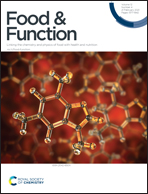Albicanol antagonizes Cd-induced apoptosis through a NO/iNOS-regulated mitochondrial pathway in chicken liver cells
Abstract
Cadmium (Cd) induces hepatocyte injury by oxidative stress. Albicanol is a sesquiterpenoid extracted from the medicinal plant Dryopteris fragrans that has previously been shown to exhibit anti-aging and antioxidant activity. In this study, we explored the mechanism of albicanol inhibition of the Cd-induced apoptosis of chicken hepatoma cells (LMH) by treating these cells with CdCl2 (25 μM) and/or albicanol (2.5 × 10−5 μg mL−1) for 24 h. Under Cd treatment, the research results showed that the apoptosis rate markedly increased in LMH cells. In addition, the iNOS activity and NO content increased significantly, which promoted the expressions of genes associated with the mitochondrial apoptosis pathway (Bax, CytC, Caspase-3 and Caspase-9) and inhibited the expression of Bcl-2 in this pathway. However, Cd + albicanol co-treatment significantly reduced the apoptosis rate and the expressions of iNOS and genes associated with the mitochondrial apoptosis pathway (Bax, CytC, Caspase-3 and Caspase-9), and promoted the expression of Bcl-2 in this pathway. In addition, molecular docking supported a link between the albicanol ligand and the iNOS receptor. These results indicated that albicanol can inhibit Cd-induced apoptosis by regulating the NO/iNOS-mediated mitochondrial pathway.



 Please wait while we load your content...
Please wait while we load your content...